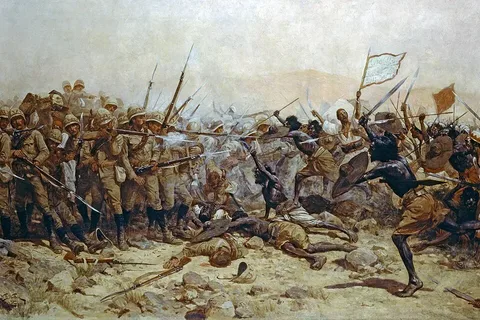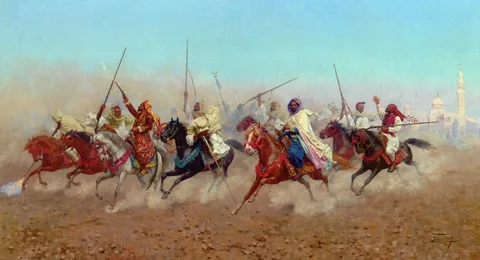The Battle of Bani Al-Nadir stands as one of the pivotal events in early Islamic history. Taking place in the month of Rabi‘ Al-Awwal, 4 AH (approximately May 625 CE), this campaign not only shaped the political and social landscape of Medina, but also demonstrated the dynamics between the nascent Muslim community and the Jewish tribes residing in and around the city.
Background: Who Were Bani Al-Nadir?
Bani Al-Nadir was one of the major Jewish tribes living in Yathrib (later known as Medina) long before the arrival of Prophet Muhammad. Historical records suggest their roots either as descendants of Aaron, the brother of Prophet Moses, or as Arab converts to Judaism. They were notably wealthy, owned large date groves, and enjoyed significant influence in Medina’s affairs.
The battle of Bani Al-Nadir (4 Hijri)
Upon the Prophet’s migration to Medina, an alliance—sometimes called the Constitution of Medina—was made between the Muslims and the various Jewish tribes, including Bani Al-Nadir. This pact stipulated mutual defense, non-collaboration with external enemies (notably the polytheistic Quraysh), and peaceful coexistence. However, political and economic rivalry led to mounting distrust. Bani Al-Nadir’s links to the Quraysh and breaches of the treaty, especially during critical times for the Muslims, amplified this tension.
Read about: The battle of the Amr (3 Hijri).
Immediate Causes: Conspiracy and Betrayal
The most prominent immediate cause centered around the aftermath of Bi’r Ma‘una. Two members of the Banu ‘Amir tribe, protected by the Prophet, were mistakenly killed by a Muslim. The Prophet, honoring tribal custom, sought compensation from their allies, Bani Al-Nadir. While initially agreeing, the tribe allegedly conspired to assassinate the Prophet while he was among them. Islamic traditions narrate that a member of Bani Al-Nadir proposed dropping a large stone on Muhammad’s head, but the plot was divinely revealed to him. He promptly left, averting the danger.
The Ultimatum and Siege
Upon uncovering the plot, Muhammad served Bani Al-Nadir an ultimatum: leave Medina within ten days or be forced out. At first, the tribe seemed willing to depart. However, Abdullah ibn Ubayy, leader of the so-called ‘hypocrites’ in Medina, encouraged them to resist, promising military support along with possible aid from Bani Qurayza. Motivated by this, Bani Al-Nadir refused to comply.
The Muslims, led by the Prophet and with Ali ibn Abi Talib carrying the standard, laid siege to the well-fortified Bani Al-Nadir settlement. The siege, which lasted between six and twenty days depending on various sources, was marked by the defenders launching arrows and stones from their fortresses and the Muslims burning some of the surrounding date palms—a tactic highlighted in the Qur’an (Surah Al-Hashr 59:5).
Outcome and Aftermath
Realizing their allies would not come, and unable to withstand the siege, Bani Al-Nadir eventually negotiated surrender. Their conditions allowed them to leave Medina with whatever they could carry, except for weapons, on their camels. It is said that around 600 camels were used to transport their possessions, with women and children adorned in finery as they left, a poignant procession through the city.
Most members relocated to Khaybar, another fertile and well-defended Jewish settlement, while a few went further north to Syria. Their confiscated lands, homes, and date groves were distributed as fay’—a special category of spoils acquired without direct combat. Islamic law granted Muhammad discretion in distributing these. He gave the bulk to the poorer Muhajirun (early Muslim emigrants), though a small number of needy Ansar (local Muslims of Medina) also received shares, following an offer and their generous decision.
Read about: The battle of Hamraa’ Al-Asad (3 Hijri).
Historical and Social Impact
The expulsion of Bani Al-Nadir significantly altered the balance of power in Medina:
-
The Muslims gained substantial economic resources, redistributing property and lands, which enhanced the community’s self-sufficiency and unity.
-
The fortifications and wealth left behind further strengthened the military and political position of the Muslims.
-
Many expelled Bani Al-Nadir became influential in Khaybar and later played roles in subsequent conflicts with the Muslims.
-
The episode is memorialized in the Qur’an (Surah Al-Hashr, verses 1–17), discussing the events and the subsequent redistribution of wealth, along with ethical lessons for the Muslim community.
FAQs
Why did the Muslims and Bani Al-Nadir initially have a treaty?
The Muslims and Bani Al-Nadir, along with other groups in Medina, agreed to a mutual defense and coexistence pact soon after Muhammad’s arrival to establish harmony and security in the multi-tribal city.
What triggered the confrontation in 4 Hijri?
The immediate trigger was Bani Al-Nadir’s alleged plot to assassinate Prophet Muhammad during a meeting about blood money compensation, breaking the peace treaty.
Was the siege of Bani Al-Nadir a violent battle?
There was little direct combat. The engagement was mainly a siege; the Bani Al-Nadir preferred remaining inside their fortresses, and fighting was primarily defensive. Ultimately, they surrendered and negotiated their departure.
How was the property of Bani Al-Nadir distributed?
The property and lands were defined as fay’ (spoils gained without battle) and distributed largely among impoverished emigrant Muslims (Muhajirun), with some allocation to the needy among the Ansar.
Where are the events of the Battle mentioned in the Qur’an?
The Qur’an documents the episode and its moral lessons in Surah Al-Hashr (Chapter 59), especially verses 1–17.
Conclusion
The Battle of Bani Al-Nadir exemplifies the intricate interplay of faith, politics, and communal allegiance in early Islamic society. It underscores key Islamic principles of contractual obligation, justice, and communal welfare, set against the harsh realities of seventh-century Arabian politics. The event’s ripple effects included shifting demographic and economic dynamics in Medina and laid important groundwork for later developments in the Prophet’s mission. The encounter is remembered not simply as a battle, but as a formative incident in the forging of the Muslim community.


